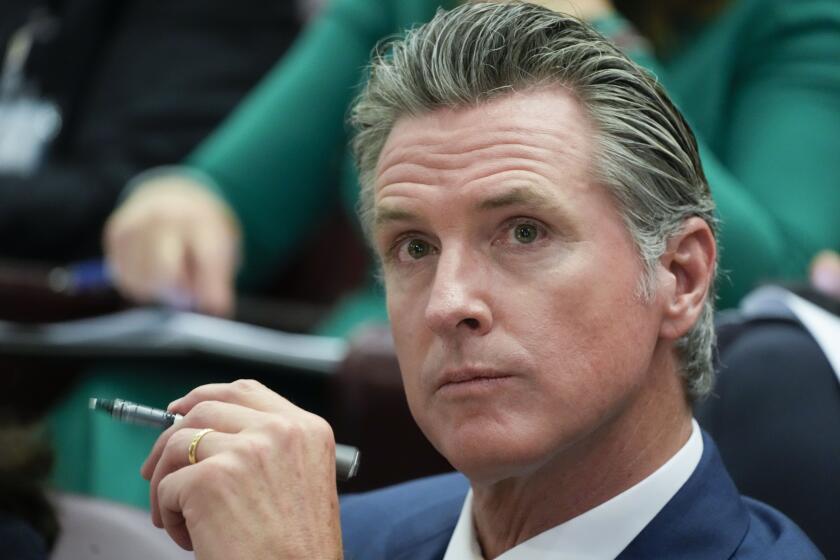Californians don’t have to accept skyrocketing electric bills. Here’s how to fight back

- Share via
You’re not alone if it seems like your electric bill is getting too damn high.
Californians pay some of the highest electric rates in the country. In the last decade households have seen their electricity rates nearly double even while their budgets are squeezed by inflation and rising temperatures from climate change mean they have to use more energy to cool their homes.
And it’s only going to get worse. State greenhouse gas reduction policies are pushing residents to adopt electric cars and appliances that will only increase their electricity consumption. Rate hikes have become bigger and more frequent, rising even faster than inflation for customers of the big three monopoly utility companies whose rates include costs for expensive wildfire mitigation, grid infrastructure projects and disaster-related payouts.
California’s rising power rates are an obstacle to climate action. Regulators need to modernize the way utilities bill their customers to encourage electrification.
In Pacific Gas & Electric territory, electric bills have climbed from $128 a month for an average residential customer in January 2020 to $226 today. Southern California Edison bills rose from $114 to $180 a month over that same period. It’s no wonder about 1 in 5 California households (and 1 in 3 low-income customers) are behind on their bills, owing an average of nearly $800.
These dramatic increases are alarming and unsustainable. This is a crisis, both for affordability and for climate action.
Much of the recent debate over electric rates has focused on the California Public Utilities Commission’s May 9 decision to shift the way electricity bills are charged to customers served by investor-owned utilities. It’s a positive step that will help smooth the way for home and vehicle electrification, but will do nothing to rein in the amount utilities are allowed to charge ratepayers.
Los Angeles adopted an effort to divert 90% of trash from landfill by next year, but residents and businesses continue to dump millions of tons of waste.
Lawmakers must address rising costs next to protect cash-strapped Californians and prevent rising electric rates from undermining the state’s climate goals. Here are four ideas they can use to kick off the discussion.
Don’t make customers pay for everything
Much of what Californians are charged on their electric bills isn’t for the cost of the power but for other purposes including the operation and maintenance of the grid, projects to reduce wildfires (power lines have sparked some of the state’s worst ones) and energy efficiency programs.
If investor-owned utilities were stripped of their responsibility for much of the spending not directly related to the generation and delivery of electricity, it would reduce the amount they could collect from customers and thus lower electric rates for everyone. One idea proposed as recently as 2022 by state Sen. Josh Becker (D-Menlo Park) is to create a state authority to publicly finance transmission line projects at lower cost.
Southern California air quality officials discussed port pollution at a luxury Rancho Mirage resort 100 miles from the harbor, when they should be adopting long-delaying rules for L.A. and Long Beach ports to slash health-damaging emissions.
Shifting costs away from ratepayers would require tough decisions about which programs to cut, which to keep and how to fund them. For example, some of the energy efficiency incentive programs, which are largely conservation-based, may have outlived their usefulness in a state pushing for electrification.
For crucial programs such as wildfire mitigation and rate assistance, it’s worth considering whether it would be more appropriate to fund them out of the state’s general fund, through bonds or through fees the state collects from polluters through its cap-and-trade program.
Limit rate increases
Although the rate increases requested by utility companies are decided by the state Public Utilities Commission, state legislators have also changed the law to allow utilities to seek more frequent rate increases outside of the normal three-year rate request process to respond to rising costs from wildfire and other climate disasters. That’s one reason why the PUC approved more than a dozen rate hikes each for PG&E and Edison since 2020.
State regulators have decided to let investor-owned utilities impose a new flat fee on your electric bill and decrease the usage charges. But customers who typically use less energy might see an increase in their bill.
But less frequent, more comprehensive rate hike proceedings that are more heavily scrutinized and holistically considered by regulators would probably be better for customers, by allowing overstretched ratepayer watchdogs more opportunity to contest the increases and scale them back.
Another idea worth considering is limiting the percentage of their income households can be made to pay for utilities. One proposal in New York would have capped utility bills in low- and moderate-income households at 6% of their income, above which customers are considered to have high energy burdens.
A recent report by the ICF Climate Center examined how extreme heat projections will affect historically marginalized groups.
Ratepayer advocates in California have floated the idea of legislation that would prohibit utilities from increasing their rates faster than inflation. The Utility Reform Network ratepayer advocacy group has suggested tying a cap on rate increases to the Social Security Administration’s annual Cost-of-Living Adjustment, which in 2023 was 8.7%.
Slash utility spending
The investor-owned utilities are spending heavily to stop their equipment from starting wildfires and to build and upgrade power lines, substations and transformers needed to handle vehicle and building electrification. But they have little incentive to be frugal because they can pass on the cost to ratepayers while also taking a healthy profit. Stronger restrictions on utility spending may force them to stop treating ratepayers like a credit card with no limit.
There is legislation pending in Sacramento that would push utilities to use the fastest and most cost-effective wildfire mitigation methods, such as insulating wires and managing vegetation, instead of the most expensive options such as undergrounding power lines, and require some utility overspending to be covered by shareholders instead of customers.
Thursday’s vote by the California Public Utilities Commission was the latest stain on the governor’s record.
Also fueling rising electric bills are shareholder returns. The money investor-owned utilities collect from customers fuels their profits, including the $2.2 billion PG&E reportedly raked in last year, a 25% increase over the year before. Lower limits on the returns they are allowed to funnel to shareholders would reduce costs to customers.
Consider a public takeover
Customers of publicly owned utilities such as the Los Angeles Department of Water and Power pay lower electric rates in large part because a profit margin isn’t part of the equation. Gov. Gavin Newsom threatened to take over the troubled PG&E during its last bankruptcy if it didn’t become a more responsible utility. Ultimately, the governor struck an oversight deal. But a public takeover is still worth exploring to protect Californians from unaffordable rates.
Also up for discussion should be reforms to the Public Utilities Commission, which critics accuse of being too friendly to the utilities and failing to protect consumers. Could the PUC be more responsive if some of its many other responsibilities — including trains, autonomous vehicles and internet service — were handed off to other agencies, or if it included voting members that weren’t appointed by the governor?
It is likely that there are many other worthy ideas to address electric rates. It’s time to start discussing them in earnest, before the affordability crisis turns into a ratepayer revolt.
More to Read
A cure for the common opinion
Get thought-provoking perspectives with our weekly newsletter.
You may occasionally receive promotional content from the Los Angeles Times.












